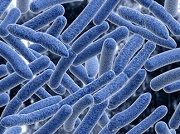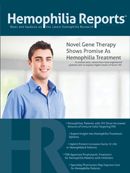Publication
Article
Hemophilia Reports
The Multifaceted Pathogenesis of Rheumatoid Arthritis
Although not completely understood, the pathogenesis of rheumatoid arthritis is thought to involve an external trigger (eg, trauma, cigarette smoke, infection) that induces an autoimmune reaction, resulting in synovial hypertrophy and chronic joint inflammation in persons who are genetically susceptible.

Susceptibility to rheumatoid arthritis (RA) is defined by a pattern of genetic and environmental factors. The most important genes include the human leukocyte antigen (HLA) and major histocompatibility (MCH) genes, but minor genes, including cytokine promoters, T-cell-signaling genes, and others, also contribute to the susceptibility for development and progression of RA. Environmental contributions include smoking, which may interact with genes to increase susceptibility by as much as 40-fold.1
Although not completely understood, the pathogenesis of RA is thought to involve an external trigger (eg, trauma, cigarette smoke, infection) that induces an autoimmune reaction, resulting in synovial hypertrophy and chronic joint inflammation in persons who are genetically susceptible. The underlying inflammatory and autoimmune processes result in the characteristic swelling, bony erosions, and synovial thickening of RA.2
The environmental component most likely repeatedly activates innate immunity, a process that can take many years, because autoimmunity increases gradually toward the appearance of clinical disease. The induction of the peptidyl arginine deiminase (PAD) enzymes, which are responsible for the conversion of arginine to citrulline, is a key component of this process. Citrullination, a normal physiologic process in dying cells, is induced early in the disease process. In normal situations the dying cells do not come in contact with the immune system, but in patients with RA, inadequate clearance results in the leaking of PAD and citrullinated proteins into the immune system. Citrullinated antigens are ultimately produced, and patients with certain HLA-DRB1 genotypes develop anticitrullinated protein antibodies (ACPAs) and loss of tolerance to self. Increased citrullination is associated with environmental stress of many types; however, the production of ACPAs is specific to RA.1-4
Of note, ACPA-positive RA is associated with a worse prognosis and has a different risk factor profile compared with ACPA-negative RA. Environmental risks such as smoking and alcohol abstinence are predominantly linked to ACPA-positive RA. These differences suggest that the two ACPA subsets may respond differently to treatments.5
Rheumatoid factor (RF) is indicative of autoantibody production. In fact, systemic autoantibody production and inflammation precede inflammation and adhesion molecule formation in the synovium, and the initial development of RF and ACPA can predate the development of clinical RA symptoms involving the synovium by as many as 15 years.6 During this pre-RA” period, systemic inflammation is also apparent, as evidenced by multiplex analysis of cytokines in the serum; these levels of cytokines continue increasing in the years before clinical symptoms of RA occur.7
Joint symptoms of RA may be in part due to local hypoxia, release of cytokines, fibroblast activation, and synovial reorganization that result in increasing inflammatory tissue. The synovial membrane becomes infiltrated with inflammatory cell types that cooperate to cause joint destruction.3
Cytokines such as interleukin (IL)-12, IL-15, IL-18, and IL-23, HLA class II molecules, and costimulatory molecules are expressed by dendritic cells, which contribute to antigen presentation and activation of T cells. Two signals are required for T-cell activation; the first signal is antigen-specific and requires T-cell receptors and IL-2, and the second (costimulatory) signal involves interaction of costimulatory (CD80/86) molecules on the antigen-presenting cell and CD28 on the T cell. Competitive inhibition of CD80/86 prevents activation of T cells and downstream activities. During T-cell activation, T helper (Th) cells such as Th0, Th1, and Th17 are recruited, resulting in production of IL-17A, IL-17F, IL-21, IL-22, and tumor necrosis factor-α (TNF-α). Th17 differentiation is promoted by the secretion of transforming growth factor β, IL-1β, IL-6, IL-21, and IL-23 by macrophages and dendritic cells, resulting in an inflammatory environment. Chondrocytes and fibroblasts are activated by coordination of IL-17A and TNF-α. Th17 cells trigger humoral immunity mediated by synovial B cells, which secrete autoantibodies and cytokines, stimulating synovial fibroblasts.3,6-10
Macrophages, mast cells, and natural killer cells are important in the pathophysiology of synovial inflammation in patients with RA. Granulocyte colony-stimulating factor and granulocyte-macrophage colony-stimulating factor mediate the maturation of macrophages, which secrete TNF-α, IL-1, IL-6, IL-12, IL-15, IL-18, and IL-23. Macrophages participate in the release of matrix degradation enzymes, phagocytosis, antigen presentation, and reactive oxygen intermediates. Inflammatory prostaglandins, proteases, and reactive oxygen intermediates are synthesized by neutrophils in the synovial fluid, and mast cells release chemokines, cytokines, and proteases.3
Signal transduction pathways such as Janus kinase pathways and mitogen-activated protein kinases (MAPKs) likely contribute to inflammation in patients with RA. Also, TNF-α and IL-6 are thought to play a central role in the pathogenesis of RA. For example, TNF-α activates cytokines, endothelial-cell adhesion molecules, and chemokine expression. In addition, it promotes angiogenesis and suppresses regulatory T-cell function. IL-6 promotes leukocyte activation and autoantibody production. It is also thought to contribute to dysregulation of lipid metabolism, as well as to anemia and cognitive impairment.3
The pathogenesis of RA is complex and continues to be delineated. Understanding of this process is critical to the ongoing development of targeted strategies for therapeutic treatment of RA and optimization of patient outcomes.
References
1. Lundstrom E, Kallberg H, Alfredsson L, Klareskog L, Padyukov L. Gene-environment interaction between the DRB1 shared epitope and smoking in the risk of anti-citrullinated protein antibody-positive rheumatoid arthritis: all alleles are important. Arthritis Rheum. 2009;60(6):1597.
2. Gibofsky A. Overview of epidemiology, pathophysiology, and diagnosis of rheumatoid arthritis. Am J Manag Care. 2012;18(suppl 13):S295-S302.
3. McInnes IB, Schett G. The pathogenesis of rheumatoid arthritis. N Engl J Med. 2011;365(23):2205-2219.
4. van Venrooij WJ, van Beers JJ, Pruijn GJ. Anti-CCP antibodies: the past, the present and the future. Nat Rev Rheumatol. 2011;7(7):391-398.
5. Seegobin SD, Ma MH, Dahanayake C, et al. ACPA-positive and ACPA-negative rheumatoid arthritis differ in their requirements for combination DMARDs and corticosteroids: secondary analysis of a randomized controlled trial. Arthritis Res Ther. 2014;16(1):R13.
6. Isaacs JD. The changing face of rheumatoid arthritis: sustained remission for all? Nat Rev Immunol. 2010;10(8):605-611.
7. Deane KD, O’Donnell CI, Hueber W, et al. The number of elevated cytokines and chemokines in preclinical seropositive rheumatoid arthritis predicts time to diagnosis in an age-dependent manner. Arthritis Rheum. 2010;62(11):3161.
8. Huppa JB, Davis MM. T-cell-antigen recognition and the immunological synapse. Nat Rev Immunol. 2003;3(12):973-983.
9. Birbara CA. Management of inadequate response to TNF-α antagonist therapy in rheumatoid arthritis: what are the options? The Internet Journal of Rheumatology. 2008;5(2). http:// ispub.com/IJRH/5/2/10669. Accessed March 21, 2014.
10. Rasheed Z, Haqqi TM. Update on targets of biologic therapies for rheumatoid arthritis. Curr Rheumatol Rev. 2008;4(4):246.





